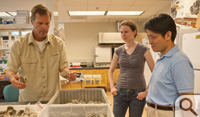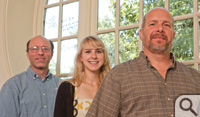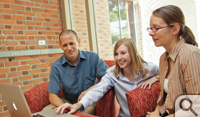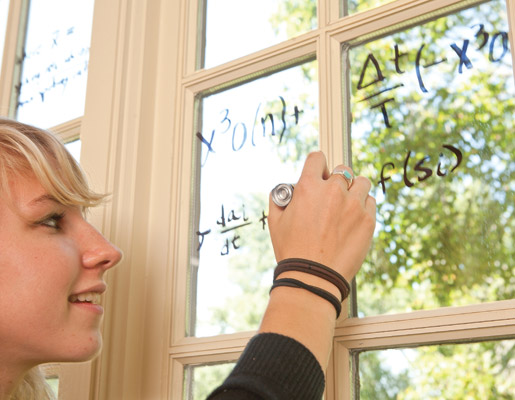Almost like magic
Mathematical modeling uses equations as a window on the workings of nature
All actions in nature can be expressed numerically.
That’s biomathematics in a very, very small nutshell.
Kiah Hardcastle has her own way to describe the concept.
“To me, it’s just magical,” she says. Hardcastle, a member of William & Mary’s class of 2012, is working with scientists in two departments on a project modeling the neuroscience of impulsive reactions. “It’s mind blowing that you could use equations to predict these kinds of things. It’s fast; I can make predictions in a few seconds, or as long as it takes my computer to run the program. It’s just really useful in a lot of ways!”
Margaret Saha says both today’s and tomorrow’s practitioners of the life sciences need to become adepts at this sort of magic.
“The major reason is that biology has changed over the last few decades. Now we are able to collect so much data that we do not know how to analyze it all without quantitative and computational approaches,” explains Saha, Chancellor Professor of Biology. “This goes for any field within biology. In ecology and evolutionary biology, you have these GIS systems which amass a huge amount of spatial information which needs to be analyzed. We apply molecular approaches to ecology, as well. Look at phylogenetics. All of this is now on the molecular level. It’s going to require quantitative approaches.”
A number of William & Mary scientists—undergraduates, graduate students, post-docs and faculty—are working within the College’s Biomathematics Initiative. Greg Smith, associate professor of applied science, is the director of the biomath program. Smith and Saha both say that the computational trend is not only changing the constellation of life-science disciplines, but also will likely attract new types of practitioners.
“Traditionally, people who major in biology have been those students who enjoy science, but they don’t necessarily like mathematics or the physical sciences,” Smith said. “The exception has been in a few areas of biology that have been quantitative for quite a long time—for example, biophysics and electrophysiology. But molecular biologists, developmental biologists, evolutionary biologists, ecologists, conservation biologists and so on—have often not had strong quantitative backgrounds. It’s becoming increasingly accepted that mathematics is the language of all natural sciences, the biological as well as the physical.”
Saha says she expects many students who are attracted to the quantitative elements of disciplines such as chemistry, physics and mathematics to become more interested in majoring in biology. She points to a real sign of the times: In the very near future, standardized tests for graduate school admission—particularly the Medical College Admission Test—will contain a much stronger quantitative aspect.
“In medical research, everything is statistically analyzed these days,” Saha explained. “Students intending to become physicians are going to need to understand how research studies are conducted. Is a drug effective or not? What populations are sampled? How was the data analyzed? Ensuring that future physicians understand these concepts is one reason why the MCAT is getting more quantitative.”
Computational concepts also are an increasingly large part of the lab life, and William & Mary’s researchers have demonstrated that biomathematical approaches are naturally interdisciplinary and often fruitful. One continuing collaboration among faculty in three William & Mary departments has already made contributions to the health of Virginia’s endangered oyster fishery. Rom Lipcius, a marine ecologist at William & Mary’s Virginia Institute of Marine Science, has been working on ways to restore the Chesapeake Bay’s native oyster population, which has declined at least 100-fold since the late 1800s.
 Several years ago, he began working with Junping Shi, associate professor of math, and Leah Shaw, assistant professor of applied science. The three began meeting each week, working out mathematical models of oyster population dynamics.
Several years ago, he began working with Junping Shi, associate professor of math, and Leah Shaw, assistant professor of applied science. The three began meeting each week, working out mathematical models of oyster population dynamics.
Sketching the model
The earliest meetings were quite basic, as Lipcius literally drew sketches: “Here is the oyster. Now the sediment comes along and the oyster filters the sediment…” Shi and Shaw caught on to the idea and soon were writing equations that described mathematically the dynamics of how oyster filtration increased, then abruptly dropped, as the mollusk became clogged by sediment. They found that filtration rate is critical to the success of a reef.
“If the water isn’t too murky, the oysters filter it and make it even better for future oyster growth. They also grow the reef higher out of the bottom muck,” Shaw explained. “This is a positive feedback loop—oysters promoting growth of more oysters.”
If sediment concentration gets too high, though, the oysters start suffocating.
The group began focusing on the relation of reef height to oyster abundance. Lipcius knew from field studies that oysters living on higher reefs tended to do better than the oysters on lower-relief reefs. The models backed him up.
“We modeled the feedback interactions between oyster reefs and sediment and showed that the system has two stable states. If the reef is too low, it further degrades toward the extinct state,” Shaw explained. “If the reef is high enough, it grows up to a stable, healthy state.”
Modeling showed a critical “tipping point” in reef height. “Less than 10 centimeters makes a difference whether a reef degrades or survives,” Lipcius says.
The group is now trying to find the “sweet spot” of minimum reef height, an elusive value because locations that receive more sediment require a higher reef height to maintain a healthy population of Crassostrea virginica.
Finding that “sweet spot” of reef height has enormous economic and ecological consequences. Lipcius says artificial oyster reefs are expensive to build, and if they’re not high enough, it’s money literally washed away. The U.S. Army Corps of Engineers Norfolk District is already taking the group’s model into account as it designs new oyster reefs for the Chesapeake.
Will Jordan-Cooley ’10 did his mathematics honors thesis on work he did as part of the oyster modeling team. His honors thesis formed the basis of a paper now in press at the peer-reviewed Journal of Theoretical Biology. Jordan-Cooley is the first author, joined by Lipcius, Shi, Shaw and Jian Shen, a research associate professor of marine science at VIMS.
 The Biomath Initiative has been a fertile ground for undergraduate participation in research projects, a result of a biology curriculum that is increasingly quantitative and a faculty in applied science and mathematics that are interested in taking on problems based in the life sciences. There has also been considerable support from William & Mary’s own Charles Center as well as the National Science Foundation (NSF), which funded several years of biomath activity through its Undergraduates in Biological and Mathematical Science (UBM) program.
The Biomath Initiative has been a fertile ground for undergraduate participation in research projects, a result of a biology curriculum that is increasingly quantitative and a faculty in applied science and mathematics that are interested in taking on problems based in the life sciences. There has also been considerable support from William & Mary’s own Charles Center as well as the National Science Foundation (NSF), which funded several years of biomath activity through its Undergraduates in Biological and Mathematical Science (UBM) program.
CSUMS steps in
Some of the highest-quality undergraduate biomath participants (including Will Jordan-Cooley) have been products of CSUMS, another NSF initiative. CSUMS is an acronym for Computational Science Training for Undergraduates in the Mathematical Sciences, a collaborative program among the departments of mathematics, applied science and computer science.
Associate Professor of Mathematics Sarah Day, one of the co-principal investigators on the CSUMS grant, explains that the program funds individual students for mentored computational research experience. CSUMS, she says, is aimed primarily at math majors. Many of the research projects focus on aspects of the life sciences.
“One goal of our CSUMS program is to promote interdisciplinary research collaborations that include undergraduate research students,” Day said. “This is an NSF requirement.”
Day says that while any student in the sciences can benefit from a background in computational math, the principles of mathematical modeling are also becoming more important in disciplines such as economics, population modeling, engineering and operations research. She’s even heard of a computational-math exploration of Romeo and Juliet.
CSUMS is an all-year project. Day says that students often start in the summer and they continue working in the CSUMS program during the following year. Over the past four years CSUMS has supported the work of 55 students, and 22 of its projects involved computational biology.
 Day and mathematician Drew LaMar worked over the summer of 2011 with CSUMS student Allison Corish ’12 on a project involving the modeling of pulse-coupled oscillators.
Day and mathematician Drew LaMar worked over the summer of 2011 with CSUMS student Allison Corish ’12 on a project involving the modeling of pulse-coupled oscillators.
“‘Pulse-coupled’ means interactions between oscillators are brief,” Corish explains. A network of pulse-coupled oscillators might be a group of synaptically connected neurons—or it could be a yard full of lightning bugs.
“When it first gets dark, the fireflies start off blinking at random, then one firefly sees another and they all start pulsing together as one or two big groups,” she said. “Likewise, neurons fire and advance the phase of other neurons, causing them to fire sooner than they otherwise would have. The equation we look at shows an oscillator firing, resetting, and at the same time causing downstream oscillators to phase advance.”
Support from HHMI’s freshman research program and William & Mary’s own Monroe Scholars program allowed Kiah Hardcastle to begin a biomath collaboration with Smith and psychologist Joshua Burk that combines empirical observation with modeling.
“This is an important study because impulsivity is a core component of several disorders, including attention deficit/hyperactivity disorder,” explains Burk, the new director of William & Mary’s Neuroscience Program. “In particular, we’re trying to understand the contribution of a particular brain region, the basal ganglia.”
The empirical portion comes from something known as the stop signal reaction time test. Burk explains that the test looks for subjects to refrain from making a particular response when a stop signal (for example, a light) is presented.
“If the stop signal is ignored, that’s considered impulsivity, a failure to withhold a previously initiated response,” Hardcastle explains.
The researchers take the information they’ve learned from the experiments and have begun to assemble a set of differential equations that model, quantitatively, the neural actions in the basal ganglia that are driving behavioral inhibition. Burk says the computation aspect brought to the project by Smith and Hardcastle has enhanced his study in several ways.
“There are a number of brain regions involved, and a mathematical model can incorporate all of them,” he said. “You can manipulate one brain region and see what changes in neural firing rates occur in a number of other brain regions. That can be difficult to do in the living organism.”
Burk, a seasoned lab experimenter, says that the 18 months of biomathematical collaboration with Smith and Hardcastle has caused him to approach his work a bit differently.
“In a lot of empirical studies, you’re predicting a change in one direction or another,” he said, “but with a math model, you need to specify exactly how much change you’re going to get. It forces you to think more specifically about what it is you’re measuring, what it is you expect to find.”
Genesis of biomath
Margaret Saha dates the beginning of William & Mary’s biomath curriculum to an afternoon in 1997. She was in her office, working on a grant application to the Howard Hughes Medical Institute when George Rublein appeared in the doorway.
“I have kind of a crazy idea,” he said. Rublein is a member of the mathematics faculty, and his idea was to propose that HHMI fund a special calculus class for students who were good candidates to go on to medical school or graduate study in one of the life sciences. The course would teach calculus using problems drawn from genetics, population dynamics, ecology, cellular biology and similar areas.
“The reviewers at HHMI loved it,” Saha says. “It was a brilliant idea.” HHMI supported hiring a biomathematician in the math department to teach a new pair of courses, Calculus for the Life Sciences I and II. Over the years, more biomath courses were added to the curriculum. Saha says there are now 15 to 20 such courses, for example, Introduction to Mathematical Biology and Cellular Biophysics and Modeling (a mathematics course required for neuroscience majors).
HHMI has been a continual supporter of William & Mary’s Biomath Initiative, funding three successive grants since the first one in the late ’90s that put a biomathematician in the math department. The most recent HHMI grant advances the same interdisciplinary concept—by putting a mathematician in the biology department.
“HHMI likes the fact that the William & Mary biologists can actually talk with the mathematicians, and both departments have been willing to cooperate,” Saha said. “We have this attitude of OK, let’s try it. We’re small enough that the typical administrative battles and hurdles don’t exist to the extent that they do in other places.”
Drew LaMar is the mathematician in the biology department. He was Greg Smith’s post-doc in applied science for three years before emerging at the top of a national search for the HHMI-funded biomath position. He started his new position as assistant professor of in the biology department this fall.
“The idea is to work with the instructors of the introductory biology courses, to infuse more quantitative concepts into these courses, to get the students more comfortable with mathematics and quantitative biology,” LaMar said.
Saha expects having a mathematician among biologists will produce a number of collateral benefits.
“There is a huge social aspect to good science—and good math,” Saha said. “Talking to colleagues informally and having these hallway conversations are really important. It’s going to be wonderful to have this mathematical, quantitative person in our face on a daily basis.”
Deterministic? Stochastic?
An elementary consideration for any sort of mathematical modeling is whether the problem at hand should be addressed through a deterministic or a stochastic approach. LaMar compares a deterministic model to Newton’s Laws of Motion—each element of each equation is established, and so the model proceeds in an orderly and predictable fashion based on its initial state.
“The stochastic system on the other hand recognizes that biology is messy,” he said. “Probability comes into play. If you get down to the level of the cell, you’re going to have Brownian motion. The end result is not determined by the initial state.”
LaMar will help to introduce both deterministic and stochastic paradigms into the introductory biology curriculum. Leah Shaw’s course, Random Walks in Biology, advances this concept.
“It’s about stochasticity or randomness in biological systems,” Shaw explains. “We start with the idea of a random walk. So, you can go left or right, and after that you can take another step, either left or right, and so on.”
The students then examine statistics that average out many random-walk trials and predict where they might end up.
“We apply this concept to a number of different biological systems and then bring in some elements in math that are good for students to learn,” she said. “These are mostly biology majors. It exposes them to some math that they might not have seen before—but using biological examples.”
A model of both the undergraduate curriculum as well as the research activity of William & Mary would no doubt predict that biomathematics is here to stay. ![]()
















